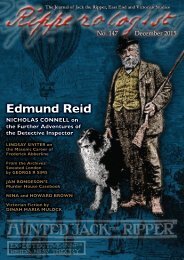GEORGE HUTCHINSON
orxwju5
orxwju5
You also want an ePaper? Increase the reach of your titles
YUMPU automatically turns print PDFs into web optimized ePapers that Google loves.
The Pick-Up Shtick<br />
By TIM MOSLEY AND SCOTT NELSON<br />
In a previous article in this series, we hypothesized as to the possible type and location of<br />
the Ripper’s presumed regular employment and as to how he might have outfitted himself in<br />
preparation for the Whitechapel Murders. We now turn an eye toward how the Ripper might have<br />
selected his victims, as well as the specific locales where he committed his murders.<br />
Two of the foremost reasons that the Whitechapel Murders were as sensational and horrifying as they were<br />
to the general public in 1888 are, first, the peculiar attitude of the Victorians toward sex and prostitutes, and,<br />
secondly, the burgeoning press that had begun to generate explicit scandal stories for popular consumption<br />
on a scale that had not been possible before. 1 These crimes occurred during a puritanical age in Britain when<br />
many a woman was shocked upon initially discovering the facts of life from her husband on her wedding night. 2<br />
Sex was simply not something to be discussed publicly, under any conditions; parodies of this quaintly prudish<br />
Victorian attitude may be found even today in plays such as No Sex, Please, We’re British. Although Victorians<br />
were forbidden by the customs of their era to discuss sex, the scandal story, which openly broadcasts information<br />
ordinarily kept secret, was an altogether different matter. Formerly, journalists had seen the misfortunes of the<br />
poor only as suitable entertainment for the more privileged readership. Then, partly as a result of the repeal of<br />
the stamp tax in 1855 and the paper duty in 1860, the number of newspapers in Britain multiplied tremendously.<br />
As newspapers became cheaper, more widely available, and more national in scope, they naturally became<br />
more competitive and hence encouraged the activities of scandal-mongering journalists. 3 The stage was set for<br />
the unparalleled media coverage of a sensational sex scandal the likes of which had never been seen before – a<br />
merciless killer who preyed upon the prostitutes that sold sex to anyone on the streets, murdering them in public<br />
locations, mutilating or removing their sexual and other bodily organs, and leaving the remains in plain sight in an<br />
unprecedented, in-your-face style which was a horrific affront to Victorian society itself.<br />
At the same time, exclusive brothels thrived in the affluent West End, where prostitutes of a much higher<br />
class than those being murdered and mutilated in the East End catered to an enthusiastic and discriminating<br />
clientele. Those patrons from the middle and upper classes largely thought of these prostitutes as ‘daughters of<br />
joy’, women who were so overwhelmed by the pleasure of sexual feelings that their pursuit became an avocation.<br />
Being relatively well-to-do themselves, many in such a position found it difficult or impossible to understand or<br />
accept the fact that women could become so desperate that they would sell their own bodies several times daily,<br />
just to survive. To quote Donald Rumbelow, 2 ‘The crude economic necessity that drove women to “sail along<br />
on their bottoms” was generally glossed over with a wishy-washy sentiment that they had fallen because they<br />
had been betrayed by a wealthy seducer.’ For others, it was a hoped-for Cinderella story of unjust oppression<br />
and eventual triumphant reward, where unfortunate women were suddenly transformed by remarkable fortune.<br />
These so-called rags-to-riches stories were vivid dreams imagined by many unfortunate East End women suffering<br />
in endless obscurity and neglect.<br />
1 Cohen, William A.: Sex, Scandal and the Novel, From Sex Scandal: The Private Parts of Victorian Fiction, Duke University Press,<br />
1996.<br />
2 Rumbelow, Donald: The Complete Jack the Ripper, London, Penguin (revised 2004).<br />
3 Cohen, William A.: Sex, Scandal and the Novel, From Sex Scandal: The Private Parts of Victorian Fiction, Duke University Press,<br />
1996.<br />
Ripperologist 146 October 2015 30




